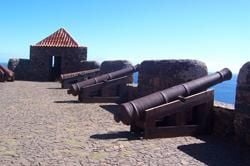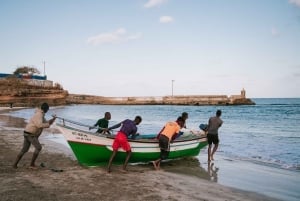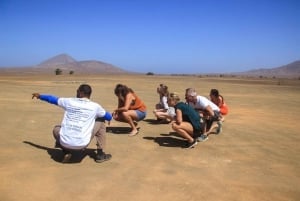Cape Verde History
Portuguese Colonization
While there is some evidence that the ancient Greeks knew about it, and even placed some mythological events inside its territory, it is the foundation of the Santiago island settlement by the Portuguese in 1462 that marks the beginning of Cape Verde's history.
Built in the South of Santiago, Ribeira Grande was the first European outpost in a tropical area. The town is known as Cidade Velha (Old Town) today, and it is a Unesco Heritage site, featuring the ruins of the oldest colonial church in the world.
Slave Traders and Pirates
The islands that make up modern Cape Verde were uninhabited until the arrival of the Portuguese conquerors. To work the fertile-looking land that had first attracted them, the new settlers started bringing in slaves off the African coast. However, they were practically only able to grow cotton, because the frequent draughts made every other cultivation very difficult. Cotton crops were later traded for more African slaves; the imperial commodity of the times.
As an important stopover for the transatlantic slave trade, the colony greatly developed, but its importance declined in the 18th century due to a combination of changing slave transportation routes and attacks by both pirates and rivals, such as France and Great Britain.
The most famous recorded pirate attack was by Sir Francis Drake, the British explorer famous for his circumnavigation of the globe. He attacked Santiago with 1,000 men in 1585, but later ordered the city to be burnt, as no treasure was obtained.
Famine and Revolution
In 1747, a drought led to a terrible famine, which didn't interest Portugal enough to send the desperately needed relief. Thousands of local people died of starvation (100,000 after a cycle of droughts) while others migrated. The decline of Cape Verde's economy continued until the abolition of slavery, but on the eve of the 19th century, the industrial revolution created the need for strategic coaling stations, and Cape Verde flourished once more.
New England Whalers
Starting in the 19th century as well, the whaling industry was responsible for early Cape Verdean immigration to New England. Known to be excellent whalers, harpoonists and steersmen, Cape Verdeans and seamen from other Portuguese colonies in West Africa were favoured as crew for New England whaling ships, which departed the region loaded with expert and hard-working Africans. The men later settled in New England in a shanty town that came to be known as New Guinea, since Cape Verde was considered part of what is today Guinea-Bissau, for as long as it remained under Portuguese domination.
Independence
In 1951, Cape Verde was no longer considered a colony; it became an overseas province of Portugal. Independence was finally achieved in 1975, when Portugal started abandoning its colonial empire.
The African Party for Cape Verde Independence (PAICV), the leader in the fight against Portuguese rule, and the only political party in existence at the moment, came to power following the first democratic elections, and it remained in control until 1991. Later on, other parties were founded, and the Movement for Democracy (MPD) was eventually able to reach power as well.
The future
In a continent riddled with human rights violations and harsh dictatorships, Cape Verde has remained, since its independence, an example of democracy and freedom from corruption.
Its natural beauty and strategic location, combined with the reputation of a peaceful democratic country, make Cape Verde one of the African countries with the greatest potential to become an increasingly popular tourist destination.












